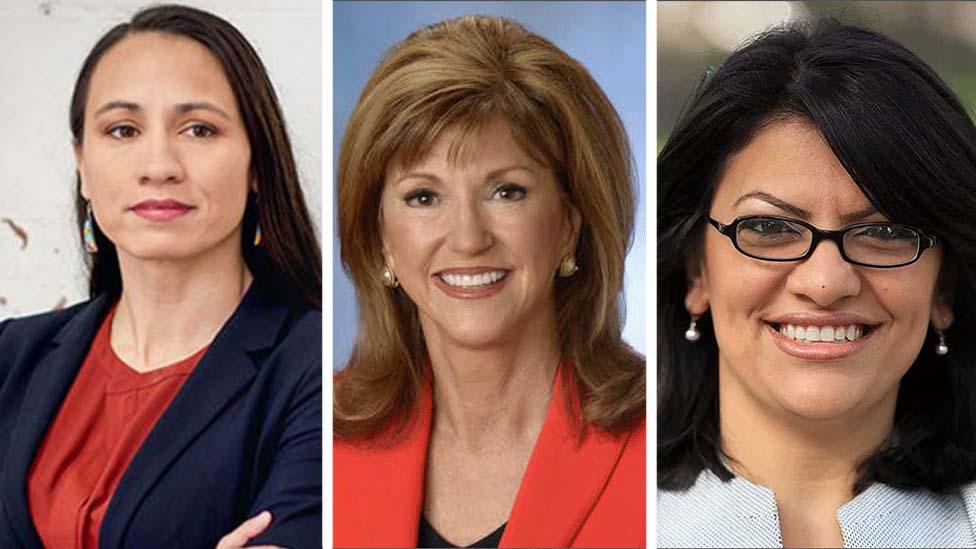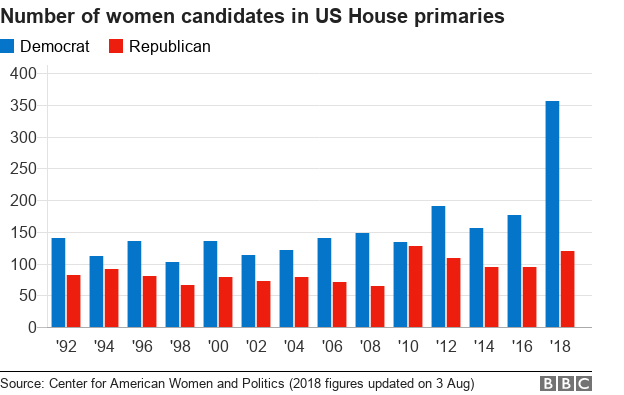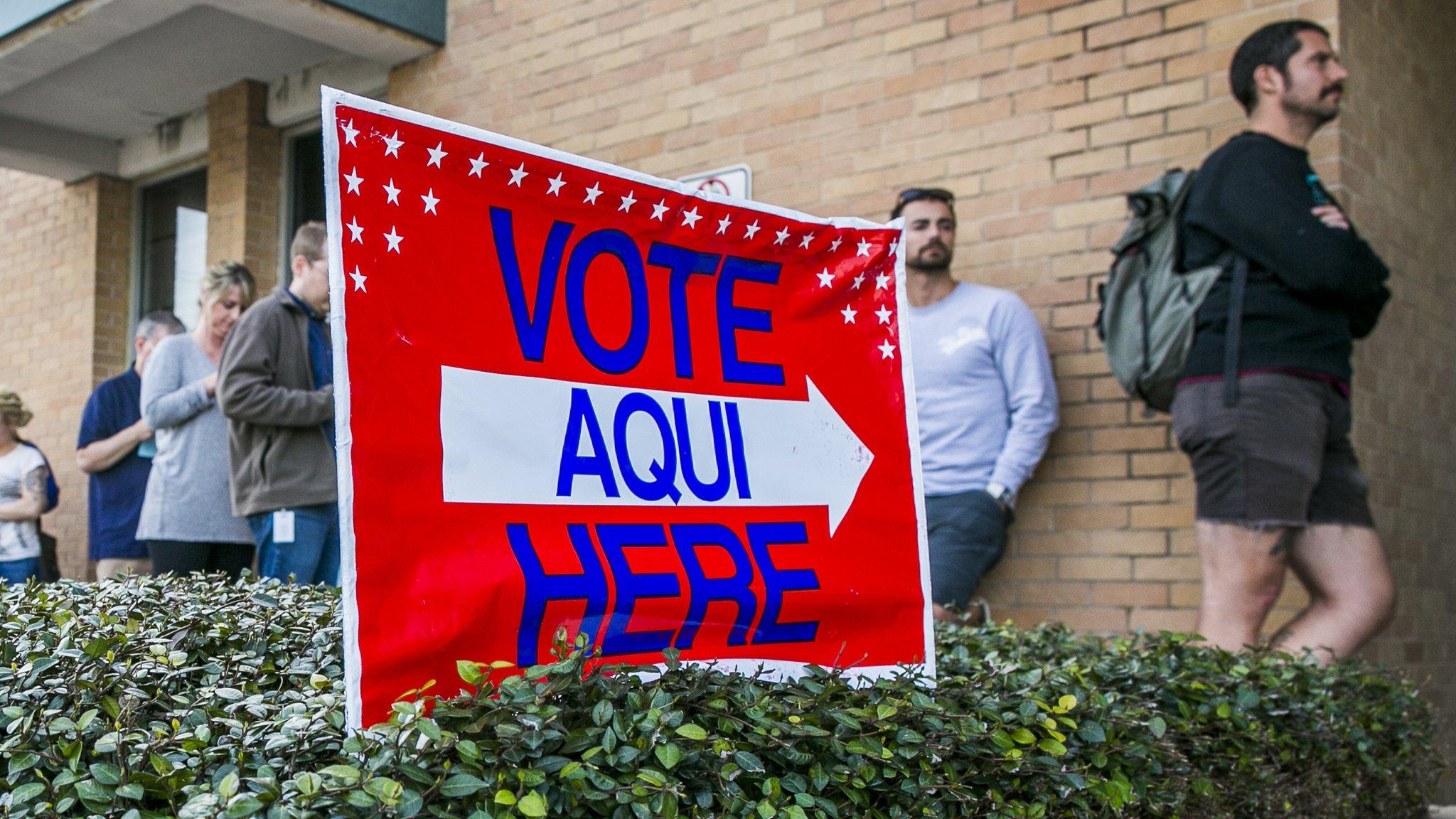US mid-term elections: Women break records for nominations
- Published

L-R Democrat Sharice Davids, Republican Susan Hutchison and Democrat Rashida Tlaib, who is almost certain to be the first Muslim woman in Congress
More women candidates than ever will contest US governorships and House seats in November's mid-term elections.
After Tuesday's primaries across four states, there are now 11 female nominees for governor and at least 185 for the House of Representatives.
The results were hailed as a continuing success story by activists for women in politics.
There was also a key election for a House seat in Ohio, in which President Donald Trump claimed victory.
But US media said the race was still too close to call, in a safe Republican seat held by them since 1983. The outcome could indicate whether Democrats have a chance to overturn the Republican majority in the House in November.
A breakthrough for women
After polling closed in the four states holding primaries on Tuesday - Kansas, Michigan, Missouri and Washington - it became clear women had broken records for gubernatorial and House nominations.
Victories for Gretchen Whitmer (Michigan) and Laura Kelly (Kansas) in Democratic primaries mean 11 women will contest governorships in November - one more than the previous 1994 record.
Allow X content?
This article contains content provided by X. We ask for your permission before anything is loaded, as they may be using cookies and other technologies. You may want to read X’s cookie policy, external and privacy policy, external before accepting. To view this content choose ‘accept and continue’.

At least 182 female major party nominees will run for the House, beating the record of 167 from 2016. Another three women are leading in close primary contests.
Debbie Walsh, director of the Center for American Women and Politics (CAWP) said: "This has been an election season of records for women candidates, and tonight continues that story."
The "Pink Wave": How women are shaping the 2018 US elections
Ms Whitmer will in fact lead a four-strong, all-women ticket for the Democrats at state level in Michigan.
In Kansas, 38-year-old Sharice Davids - a gay ex-mixed martial arts fighter - won her primary and could become the first Native-American woman elected to Congress.
Ms Davids, a member of the Ho-Chunk Nation, was raised by a single mother who worked as a drill sergeant in the US Army. Her campaign ran adverts showing her hitting a punching bag.
Allow Instagram content?
This article contains content provided by Instagram. We ask for your permission before anything is loaded, as they may be using cookies and other technologies. You may want to read Meta’s Instagram cookie policy, external and privacy policy, external before accepting. To view this content choose ‘accept and continue’.

Another Native-American woman, Democrat Deb Haaland of New Mexico, became a congressional nominee in June.
And one of the candidates for the House in the state is all but certain to become the first Muslim woman in Congress. Rashida Tlaib won a Democratic nomination and will not be opposed by the Republicans in November. She will also be the first Palestinian-American congresswoman.
The US state about to finally elect a woman
There will be two all-female races in Washington state. Democrat Lisa Brown faces Cathy McMorris Rodgers for a House seat, while Republican Susan Hutchison will take on incumbent Senator Maria Cantwell.
Democratic women could outnumber their white male colleagues in the House after November, a recent study suggested.

What has happened in Ohio?
Republican candidate Troy Balderson has been taking on Democrat Danny O'Connor for a seat in the House of Representatives. Ohio is one of the key battleground states in the mid-terms.
Mr Trump tweeted "Congratulations to Troy Balderson on a great win in Ohio. A very special and important race!"
Despite this, US news outlets have not called the contest yet. The New York Times gave Mr Balderson 50.2%, external, a lead of 1,754 votes in the 12th Congressional District race, with all precincts reporting. But thousands of absentee and provisional ballots are still outstanding, which could lead Mr O'Connor to force a recount. He said: "We're not stopping now."
A provisional ballot is used to record a vote when there are questions about a voter's eligibility. Absentee ballots are cast by those unable to attend polling stations.

Donald Trump travelled to Ohio to support Troy Balderson
Democrat House representative Ben Ray Luján said the seat should have been a "slam dunk" for the Republicans and the closeness of the contest was an "ominous sign" for them in November.
Mr Trump won the 12th Congressional District in 2016 by more than 11 percentage points.
Mr Balderson and Mr O'Connor will have to fight the seat again in November.
Anything else from the primaries?
It appears Donald Trump has had success in getting the candidates he endorsed nominated.
They include John James, an African-American Republican, who won the Senate race nomination in Michigan, and key ally Bill Schuette, who will take on Ms Whitmer for governor in the same state.
Allow X content?
This article contains content provided by X. We ask for your permission before anything is loaded, as they may be using cookies and other technologies. You may want to read X’s cookie policy, external and privacy policy, external before accepting. To view this content choose ‘accept and continue’.
The Kansas gubernatorial election has been rancorous for Republicans.
Mr Trump's controversial endorsement of the hard-right Kris Kobach over incumbent Jeff Colyer may have just about paid off. Mr Kobach holds a lead of just under 200 votes with all precincts reporting, but again provisional and other ballots are still outstanding.
Estes vs Estes
And one interesting sidebar: Ron Estes has beaten Ron Estes in a Kansas Republican primary.
The victorious incumbent congressman had to fund a campaign to spell out which candidate was which. The beaten candidate was Ron M Estes - his opponent said the M stood for misleading.
The beaten man's campaign was described by some analysts as "not serious".
The winning Ron Estes took about 80% of the vote and will face Democrat James Thompson, a supporter of Bernie Sanders in November.
What's up for election in November?
All 435 House seats, 35 of the 100 Senate seats and 36 of 50 governor races are to be fought.
Why are US election campaigns never-ending? Ask America has the answer
The Democrats need to pick up 23 seats in the House to gain a majority.
With dozens of Republican lawmakers retiring this year, the minority party has a decent chance of taking over the House.
In the Senate they need just two seats to take control. But the Republicans are tipped to retain their majority and perhaps even consolidate it.
A general opinion poll of voting intentions last Friday suggested Democrats were 6.1 percentage points ahead of Republicans.
- Published8 June 2018

- Published6 November 2018

- Published4 November 2018
- Published23 May 2018

- Published18 July 2018
